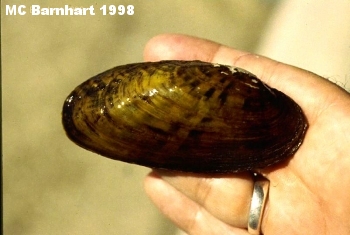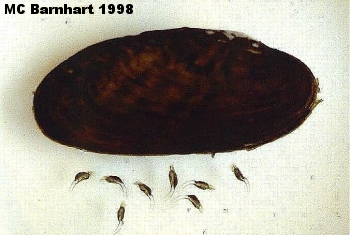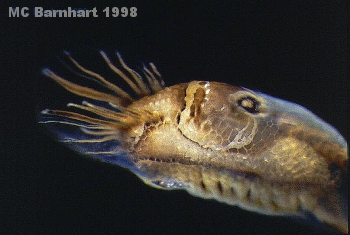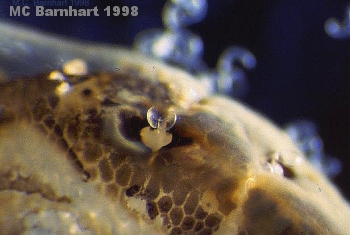| Clam-pirism: the underhanded tactics of parasitic mussels |
To many of us, bivalves such as freshwater mussels seem like the antithesis of biological cunning; armored
lumps of slimy meat that do little more than lie on river bottoms and sift food from the surrounding muck.
Many species, however, begin their lives parasitically in the bodies of fish, and employ a wide variety of
bizarre, aggressive tactics to lure their hosts.
lumps of slimy meat that do little more than lie on river bottoms and sift food from the surrounding muck.
Many species, however, begin their lives parasitically in the bodies of fish, and employ a wide variety of
bizarre, aggressive tactics to lure their hosts.
| Written by Jonathan Wojcik |
| All images (unless otherwise noted) graciously provided by Unio gallery |

Generally unable to move of their own accord, the parasite larva or glochidium can do little more than
clamp down on the first thing that brushes by its cute little jaws, sometimes equipped with vicious fangs
and an adhesive tongue. Once attached, the host's skin will grow to encase the tiny hitchhiker, which
remains for days or weeks until ready to drop off and settle down as a young mussel. Other species even
allow themselves to be swallowed, and settle in the digestive tract where they may absorb nutrients until
they are excreted. Usually only compatible with a single fish species, they rely on their parents to infect
the right host with all manner of devilry...
clamp down on the first thing that brushes by its cute little jaws, sometimes equipped with vicious fangs
and an adhesive tongue. Once attached, the host's skin will grow to encase the tiny hitchhiker, which
remains for days or weeks until ready to drop off and settle down as a young mussel. Other species even
allow themselves to be swallowed, and settle in the digestive tract where they may absorb nutrients until
they are excreted. Usually only compatible with a single fish species, they rely on their parents to infect
the right host with all manner of devilry...
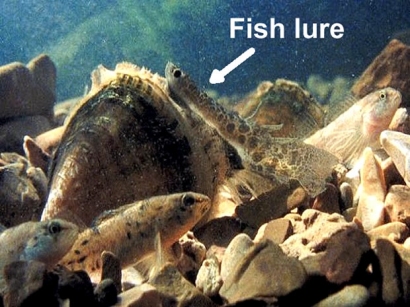
Now, I know what some of you might be thinking here. "Fish lure? Where? Behind the fish?" You're looking at
some of the most sophisticated mimicry in the animal kingdom, an appendage of the freshwater Broken Rays
mussel that even moves like a small fish in the water's current.
some of the most sophisticated mimicry in the animal kingdom, an appendage of the freshwater Broken Rays
mussel that even moves like a small fish in the water's current.
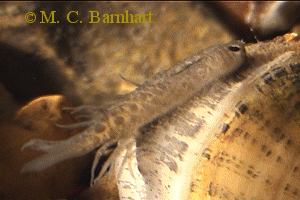
This dummy is known as a "higgin's eye," and conceals a brood pouch packed with glochidia. When a hungry
bass bites down on this dubious snack, it ruptures the pouch and gets a whole faceful of parasites that cling to
the insides of its gills. Several varieties of mussel display this behavior, with lures that range from simple
tentacle-like filaments to lures even more sophisticated than the fish-mimic, such as one that actually imitates
the undulating limbs of a crayfish. Does it get any stranger? Of course it does.
bass bites down on this dubious snack, it ruptures the pouch and gets a whole faceful of parasites that cling to
the insides of its gills. Several varieties of mussel display this behavior, with lures that range from simple
tentacle-like filaments to lures even more sophisticated than the fish-mimic, such as one that actually imitates
the undulating limbs of a crayfish. Does it get any stranger? Of course it does.
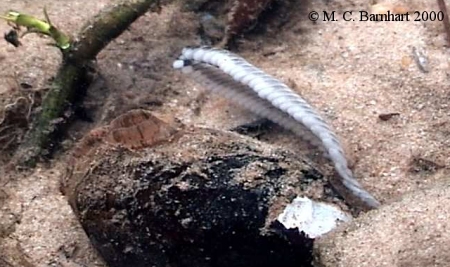
In a few species, eggs are released in a lure called a superconglutinate, dangled on a "fishing line" of mucus
that can extend several feet. Here we see the ghostly pale lure of Lampsilis perovalis, the "Orange nacre
mucket," floating just inches away from its momma. I love that name. Orange nacre mucket. Orange nacre
mucket. Say it with me! The superconglutinate consists of many tiny packets in two loosely connected rows,
which may split apart in the water's current to cover even more ground. Orange nacre mucket.
that can extend several feet. Here we see the ghostly pale lure of Lampsilis perovalis, the "Orange nacre
mucket," floating just inches away from its momma. I love that name. Orange nacre mucket. Orange nacre
mucket. Say it with me! The superconglutinate consists of many tiny packets in two loosely connected rows,
which may split apart in the water's current to cover even more ground. Orange nacre mucket.
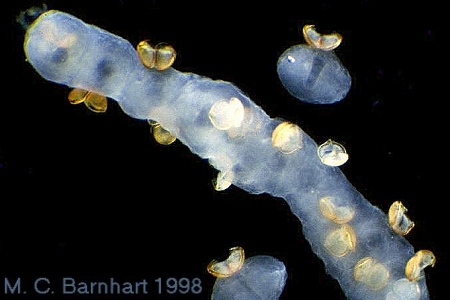
In strophitus undulatus, larvae come attached to gelatinous strands that cling like glue to their surroundings.
The little ones will clamp down on the fins of any fish that brushes past, and are strong enough for a single
individual to drag along an entire chain of siblings. Look at all those eager little babies!
The little ones will clamp down on the fins of any fish that brushes past, and are strong enough for a single
individual to drag along an entire chain of siblings. Look at all those eager little babies!
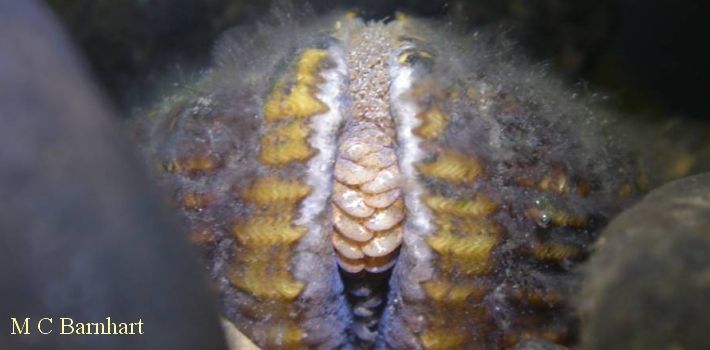
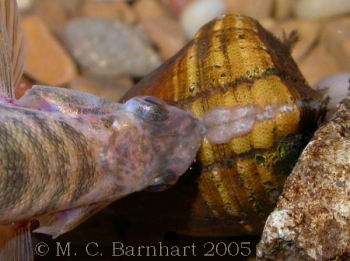
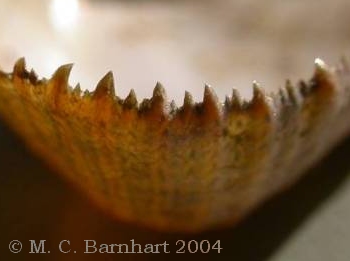
Far more aggressive is the "Snuffbox" mussel, Epioblasma triquetra. Females alone are equipped with barbed
teeth along the edges of their shells, which can snap shut like a bear trap on the nose of a bumbling fish.
Glochidia are squirted directly into the mouth of the struggling victim, settling in the gills where they remain for
up to two weeks. Its primary host, the Logperch, is just sturdy enough to survive this attack, but its powerful grip
has been known to smash the skulls of other interlopers.
Another jaw-trap is the Northern Riffleshell, which lacks these wicked fangs but attacks with suffocation,
smothering small fish by inflating its soft mantle. By the time it releases its hold, the fish can only lie gasping in
its slimy embrace, inhaling thousands of larvae before it has the strength to escape.
teeth along the edges of their shells, which can snap shut like a bear trap on the nose of a bumbling fish.
Glochidia are squirted directly into the mouth of the struggling victim, settling in the gills where they remain for
up to two weeks. Its primary host, the Logperch, is just sturdy enough to survive this attack, but its powerful grip
has been known to smash the skulls of other interlopers.
Another jaw-trap is the Northern Riffleshell, which lacks these wicked fangs but attacks with suffocation,
smothering small fish by inflating its soft mantle. By the time it releases its hold, the fish can only lie gasping in
its slimy embrace, inhaling thousands of larvae before it has the strength to escape.
These are all deliciously strange adaptations, but I've saved the best (in my personal opinion) for last. The
bivalve kings, or more accurately queens of sneaky parasite delivery are almost certainly the kidneyshells,
whose glochidia are housed in tiny cases called "ovisacs." Once released by their mother, these capsules drift in
the water's current until their sticky tails adhere to rocks or vegetation. As you can see, these surprise packages
bear shocking resemblance to tiny, baby fish or insect larva, and some varieties display even more specific
mimicry...
bivalve kings, or more accurately queens of sneaky parasite delivery are almost certainly the kidneyshells,
whose glochidia are housed in tiny cases called "ovisacs." Once released by their mother, these capsules drift in
the water's current until their sticky tails adhere to rocks or vegetation. As you can see, these surprise packages
bear shocking resemblance to tiny, baby fish or insect larva, and some varieties display even more specific
mimicry...
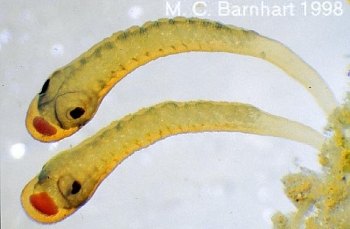
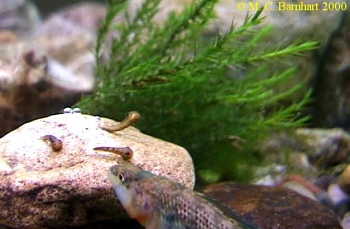
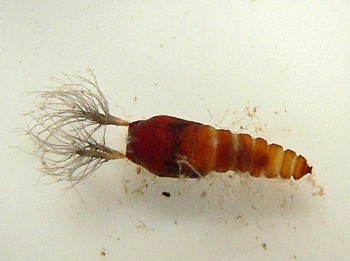
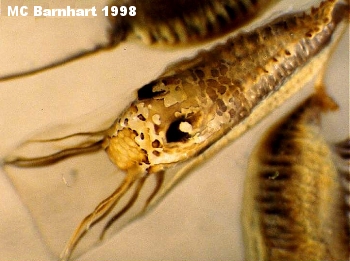
On the left, we see the aquatic pupa of a common blackfly, an insect. On the right, we see the ovisacs of the
fluted kidneyshell, Ptychobranchus subtentum. To be weirder than was even necessary, the darkened eye-spots
of some ovisacs are the main rupture points through which their parasitic payload emerges.
fluted kidneyshell, Ptychobranchus subtentum. To be weirder than was even necessary, the darkened eye-spots
of some ovisacs are the main rupture points through which their parasitic payload emerges.
Check out this incredible sequence for a sense of scale - the final photo shows us a glochidium emerging from
its ovisac's false eye. Once again, these gorgeous and rare images come to us from Unio gallery, an
educational resource on these fantastic life cycles with many more images, detailed information on several more
species and some absolutely kick-ass video footage. You probably didn't think that videos of clams could kick
ass before you came here, but by now, I hope that some of you have reconsidered.
its ovisac's false eye. Once again, these gorgeous and rare images come to us from Unio gallery, an
educational resource on these fantastic life cycles with many more images, detailed information on several more
species and some absolutely kick-ass video footage. You probably didn't think that videos of clams could kick
ass before you came here, but by now, I hope that some of you have reconsidered.

| drawing by Jonathan Wojcik |
